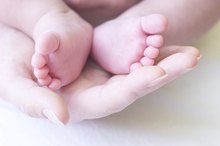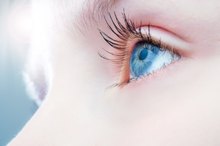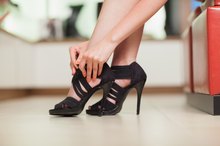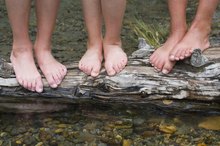How to Fix Hammer Toe On Children
Hammertoes are the result of birth defect, ill fitting shoes or pressure from bunions. Children's hammertoes are treated to effectively remove pressure and prevent future complications that could arise such as nerve damage. It is important to consult your pediatrician for treatment options when severe hammertoe is present. In cases of severe hammertoe, surgery is your only option. Mild to moderate hammertoe can be treated at home and with the help of a podiatrist or pediatrician.
If you are experiencing serious medical symptoms, seek emergency treatment immediately.
Buy your child well fitted shoes with plenty of room for growth. According to the New York Times, shoes with a wide, boxed toe and that are the right size for his foot will alleviate pressure 1. This in turn provides enough room for your child's toes to spread out, avoiding crowding.
Foot Growth in Children
Learn More
Help your child stretch her toe muscles several times throughout the day to loosen tight ligaments and muscles, suggests MayoClinic.com. Grasp her toes with your hand and gently pull them back towards her ankle. Make sure that you do not stretch them too far, as this can cause discomfort or injury.
Assist your child in picking marbles up from the floor with his toes. According to MayoClinic.com, this will help strengthen his toes and correct hammertoe situations 2. Placing a few marbles on the floor, instruct your child to grasp one marble at a time with his toes. You could make a game out of this for younger children by seeing who can pick up the most marbles in a set time limit.
Symptoms of Forearm Tendinitis
Learn More
Place a splint on your child's foot during the day, suggests the New York Times. A splint will keep her toe in a straightened position and protect it from pressure and unnecessary movement. Splints are available at your local pharmacy.
Apply an over-the-counter corn pad or felt pad to the "knuckle" of your child's toe. This will eliminate pressure and help ease pain from friction with her shoes, according to the New York Times.
Related Articles
References
- New York Times: Hammer Toe-Symptoms, Diagnosis and Treatment
- Mayo Clinic: Hammertoe and mallet toes: Lifestyle and Home Remedies
- American Orthopaedic Foot & Ankle Society. Hammertoe surgery.
- U. S. National Library of Medicine. Hammer toe. MedlinePlus.
- American Academy of Orthopaedic Surgeons. Hammer toe.
- Cleveland Clinic. When is surgery necessary for hammertoe?
- American Orthopaedic Foot & Ankle Society. Hammertoe surgery.
- Harvard Health Publishing. Hammertoe.
- Encyclopedia Britannica. Hammertoe.
- U.S. National Library of Medicine. Tests and visits before surgery. MedlinePlus.
- American Orthopaedic Foot & Ankle Society. How to prepare for foot or ankle surgery: Before surgery.
- American Orthopaedic Foot & Ankle Society. How to prepare for foot or ankle surgery: Day of surgery.
- American Orthopaedic Foot & Ankle Society. Flexor to Extensor Tendon Transfer.
- U.S. National Library of Medicine. Hammer toe repair – discharge. MedlinePlus.
Writer Bio
Sharin Griffin has been a freelance writer since 2009, specializing in health-related articles. She has worked in the health-care industry as a certified nursing assistant and medical technician. Griffin's medical expertise encompasses bariatrics and geriatric care, with an emphasis on general medicine. She is completing an associate degree in health-care administration from Axia University.









